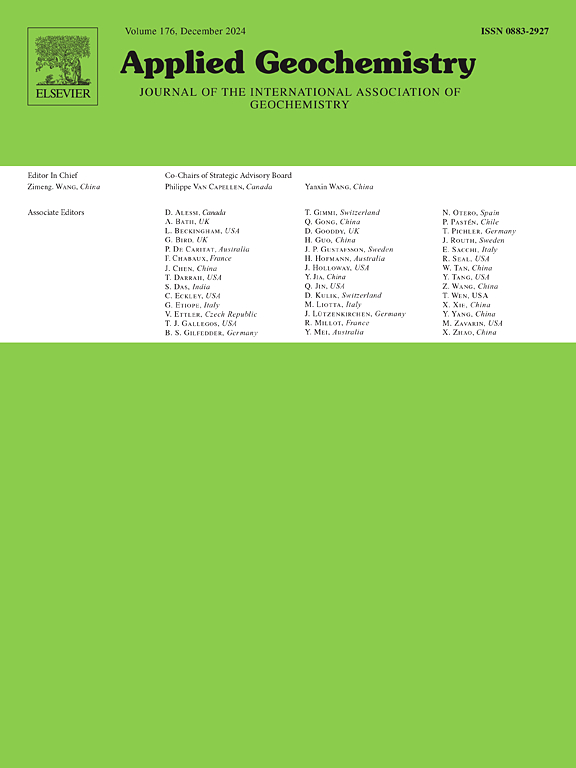Sediment color as a predictor of the subsurface redox conditions at large scale
IF 3.4
3区 地球科学
Q1 GEOCHEMISTRY & GEOPHYSICS
引用次数: 0
Abstract
The redox conditions of the subsurface are critical for predicting nitrate transport and fate in groundwater. Groundwater chemistry of redox-sensitive parameters can be used to infer subsurface redox conditions; however, it typically provides only point-scale information and requires significant time and effort to acquire large datasets. In soil science, soil/sediment colors have been used to qualitatively infer redox status in different soil horizons. In this study, we quantitatively assessed the potential of sediment color as a proxy for subsurface redox conditions at a national scale in Denmark. We did so by comparing sediment color classifications with groundwater redox conditions from approximately 4000 groundwater screens across the country. The sediment color dataset included seven base colors i.e., red, yellow, black, blue, green (olive), gray, and brown, encompassing a total of 89 variations, accounting for nuances (e.g., yellowish, grayish) and lightness (light vs dark). Our results revealed that, overall, qualitative redox interpretations based on sediment color aligned well with the oxic groundwater fraction. Gray and brown groups were the predominant colors, and within each group, the oxic water fraction increased with oxic-associated nuances (e.g., yellowish gray) and lighter shades (e.g., light yellowish gray) compared to their respective base color (i.e., gray). Most brown colors and gray shades with oxic (e.g., yellowish gray) and brownish nuances (e.g., brownish gray) showed oxic water fractions that decreased exponentially with increasing depth, suggesting hydrological controls on the redox conditions. Based on these findings, sediment color data from more than 27,000 boreholes across the country were quantitatively translated into oxic probability, enabling more precise delineation of the redox interface. Since sediment color data can be collected rapidly and at large scales, it provides a reliable and cost-effective means of assessing subsurface redox conditions. Therefore, sediment colors data have great potential to enhance large-scale modelling of redox-sensitive contaminant transport and fate.
沉积物颜色作为地下大尺度氧化还原条件的预测因子
地下的氧化还原条件是预测硝酸盐在地下水中的运移和归宿的关键。地下水化学氧化还原敏感参数可用于推断地下氧化还原条件;然而,它通常只提供点尺度的信息,并且需要大量的时间和精力来获取大型数据集。在土壤科学中,土壤/沉积物颜色已被用来定性地推断不同土壤层的氧化还原状态。在这项研究中,我们定量评估了丹麦全国范围内沉积物颜色作为地下氧化还原条件代表的潜力。我们通过比较全国大约4000个地下水屏幕的沉积物颜色分类和地下水氧化还原条件来做到这一点。沉积物颜色数据集包括7种基本颜色,即红色、黄色、黑色、蓝色、绿色(橄榄色)、灰色和棕色,总共包含89种变化,包括细微差别(例如,黄色、灰色)和亮度(浅色vs深色)。我们的研究结果表明,总体而言,基于沉积物颜色的定性氧化还原解释与含氧地下水组分很好地吻合。灰色和棕色组是主要颜色,在每一组中,与各自的底色(即灰色)相比,氧的水分数随着氧相关的细微差别(例如,黄灰色)和较浅的色调(例如,浅黄灰色)而增加。大多数带氧的棕色和灰色(如黄灰色)和带棕色细微差别(如褐灰色)显示,含氧水组分随着深度的增加呈指数下降,表明水文控制氧化还原条件。基于这些发现,来自全国27,000多个钻孔的沉积物颜色数据被定量地转化为氧化概率,从而能够更精确地描绘氧化还原界面。由于沉积物颜色数据可以快速、大规模地收集,因此它提供了一种可靠且经济有效的评估地下氧化还原条件的方法。因此,沉积物颜色数据具有很大的潜力,可以增强氧化还原敏感污染物运输和命运的大规模建模。
本文章由计算机程序翻译,如有差异,请以英文原文为准。
求助全文
约1分钟内获得全文
求助全文
来源期刊

Applied Geochemistry
地学-地球化学与地球物理
CiteScore
6.10
自引率
8.80%
发文量
272
审稿时长
65 days
期刊介绍:
Applied Geochemistry is an international journal devoted to publication of original research papers, rapid research communications and selected review papers in geochemistry and urban geochemistry which have some practical application to an aspect of human endeavour, such as the preservation of the environment, health, waste disposal and the search for resources. Papers on applications of inorganic, organic and isotope geochemistry and geochemical processes are therefore welcome provided they meet the main criterion. Spatial and temporal monitoring case studies are only of interest to our international readership if they present new ideas of broad application.
Topics covered include: (1) Environmental geochemistry (including natural and anthropogenic aspects, and protection and remediation strategies); (2) Hydrogeochemistry (surface and groundwater); (3) Medical (urban) geochemistry; (4) The search for energy resources (in particular unconventional oil and gas or emerging metal resources); (5) Energy exploitation (in particular geothermal energy and CCS); (6) Upgrading of energy and mineral resources where there is a direct geochemical application; and (7) Waste disposal, including nuclear waste disposal.
 求助内容:
求助内容: 应助结果提醒方式:
应助结果提醒方式:


